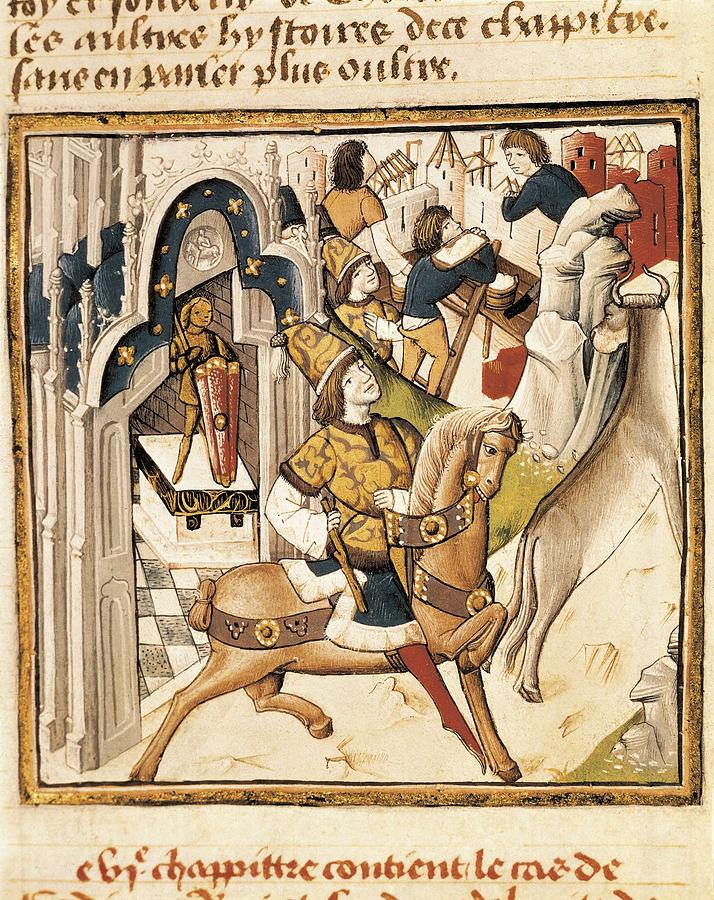
« Le Champion des Dames, » par « MARTIN LE FRANC, prevost de l'église de… Le champion, Église
A witch riding a broom from Le Champion des Dames by Martin Le Franc. c. 1440 ()This colourful illustration is the earliest know depiction of a witch riding a broomstick. It is taken from an enormous, 24,000 verse, poem known as 'Le Champion des Dames' (The Champion of Ladies), which was composed by Martin Le Franc sometime between AD 1440 and 1442.

c.1460.Champion des damesBM Grenoble Ms352.f346v.Martin Le Franc. Le Maître du Champion des
The earliest known image of witches on brooms dates to 1451, when two illustrations appeared in the French poet Martin Le Franc's manuscript Le Champion des Dames (The Defender of Ladies). In.

« Le Champion des Dames, » par « MARTIN LE FRANC, prevost de l'église de Lausane. » (1440). Date
Le champion des dames, Volume 4 Classiques français du Moyen Age, ISSN 0755-1959 Volumes 127-131 of Classiques français du moyen âge : collection de textes français et provençaux antérieurs à 1500 Le champion des dames, Martin Le Franc: Author: Martin Le Franc: Editor: Robert Deschaux: Publisher: H. Champion, 1999: Original from: the.

« Le Champion des Dames, » par « MARTIN LE FRANC, prevost de l'église de Lausane. » (1440). Date
Library of Congress. Lessing J. Rosenwald collection, 397 Goff, F.R. Incunabula in American libraries, F-277 Copinger, W.A. Supplement to Hain's Repertorium bibliographicum, 7311 Pellechet, M. Catalogue général des incunables des bibliothèques publiques de France, 4892 Also available in digital form on the Library of Congress Web site. LC copy: Provenance: Robert Samuel Turner (bookplate).

« Le Champion des Dames, » par « MARTIN LE FRANC, prevost de l'église de Lausane. » (1440). Date
Title Le champion des dames. Contributor Names Le Franc, Martin, approximately 1410-1461. Created / Published

c.1460.Champion des damesBM Grenoble Ms352.Martin Le Franc. Le Maître du Champion des dames est
According to Witchcraft in Europe, 400-1700: A Documentary History, edited by University of Pennsylvania history professors Alan Charles Kors and Edward Peters, Le Champion des Dames has "the first such illustration in the pictorial history of witchcraft."

« Le Champion des Dames, » par « MARTIN LE FRANC, prevost de l'église de Lausane. » (1440). Date
The Champion of Ladies (1440-42) by Martin Le Franc represents the most extensive defense of women (24,336 octosyllabic verses) within a long series of vernacular works in prose and poetry comprising the corpus of La Querelle des Femmes, which took place during the fifteenth and sixteenth centuries in France.1 In the Champion of Ladies, an allegorical response to classical and contemporary.

Champion Des Dames, Master Of S. Xv. De Photograph by Everett Fine Art America
Martin le Franc (c. 1410 - 1461) was a French poet of the late Middle Ages and early Renaissance.. Life and career. He was born in Normandy, and studied in Paris.He entered clerical orders, becoming an apostolic prothonotary, and later becoming secretary to both Antipope Felix V and Pope Nicholas V.. He was named provost at Lausanne in 1443, and became canon of the Church of Geneva in 1447.

Le Champion des Dames Du "Maître du Champion des Dames" ti… Flickr
Playing time: 70' Recording date: November 2002 (Notre-Dame de Centeilles) This program is organized around by Martin Le Franc (c.1410-1461), one of the most influential poems of the era. Le Franc argues for the honor of the female gender, part of a debate which raged at that time, and also mentions the famous composers Dufay & Binchois.

Le champion des dames by MINIATURIST, French
Title: Two Waldensian Witches, from Le champion des dames Creator: Possibly Barthélemy Poignare Description: This illumination depicts two women, one astride a broom and the other sitting upon a stick. The women both wear long-sleeved dresses with scooped necklines, black boots, and white head coverings.

Le champion des dames Art de l'enluminure n° 40
Champion des dames work by Martin le Franc Learn about this topic in these articles: discussion of Dunstable In John Dunstable.Franc, who wrote in his Champion des dames ( c. 1440) that the leading composers of the day, Guillaume Dufay and Gilles Binchois, owed their superiority to what they learned from Dunstable's "English manner." Read More

« Le Champion des Dames, » par « MARTIN LE FRANC, prevost de l'église de Lausane. » (1440). Date
Le champion des dames. : Le Franc, Martin, approximately 1410-1461 : Free Download, Borrow, and Streaming : Internet Archive Le champion des dames. by Le Franc, Martin, approximately 1410-1461 Publication date 1999 Publisher Paris : H. Champion Collection inlibrary; printdisabled; internetarchivebooks Contributor Internet Archive Language French

c.1460.Champion des damesBM Grenoble Ms352.Martin Le Franc. Le Maître du Champion des dames est
As in Le Champion des Dames, Martin prizes practice over theory, addressed by Martin Le Frane to the secretaries of the Savoy chancery, and frequent doing Dver abstract knowledge: dated to the late 1430s, that is even more specifically rhetorically oriented. Il was further described by Staehelin and elucidated by Strohm. 48 Martin Le Certain.

« Le Champion des Dames, » par « MARTIN LE FRANC, prevost de l'église de Lausane. » (1440). Date
Le Champion des Dames Item Preview Champion_des_dames_pp132v_133r.jpg . Champion_des_dames_pp4v_5r.jpg . remove-circle Share or Embed This Item. Share to Twitter. Share to Facebook. Share to Reddit. Share to Tumblr. Share to Pinterest. Share via email.

« Le Champion des Dames, » par « MARTIN LE FRANC, prevost de l'église de Lausane. » (1440). Le
As depicted by Martin Le Franc in Le Champion des Dames, this battle takes on literally epic proportions. Translated from the original Middle French by Steven Millen Taylor, the fourth book of.

How Witches' Brews Helped Bring Modern Drugs to Market Science Smithsonian
The Ash Wednesday Supper (1584), by Giordano Bruno (1548-1600) Conversation with the Sidereal Messenger (1610), by Johannes Kepler (1571-1630) Dialogue Concerning the Two Chief World Systems (1632), by Galileo Galilei (1564-1642) Principles of Philosophy (1644), by René Descartes (1596-1650) Weekly Readings. 1. 2. 3.